BOOK AN APPOINTMENT


In simple terms lab diamonds are an ethical alternative to mined diamonds. T hey are created using groundbreaking cuttingedge technology in laboratories, using the same principles that natural diamonds require to be formed - heat, pressure, and carbon. Lab grown diamonds take just weeks to be created, but they reflect every aspect of a natural diamond visually and chemically at a fraction of the cost.
Lab grown diamonds present a cost-effective alternative to mined diamonds. For instance, a round 1.00CT D VS1 lab grown diamond costs only £600, a staggering 75% less than its natural diamond equivalent. It's no wonder why an increasing number of consumers are opting for lab diamonds. Another example is a round 2.00CT E VS1 lab diamond, which can be acquired for just £1,644. For a wide selection of diamonds, with hundreds of diamonds available right here in the UK, feel free to explore our "select a diamond page" page.


With the advent of lab grown diamonds, it has become apparent that they outperform mined diamonds in every aspect. Firstly, customers can benefit from an average saving of 75% while still enjoying a product of comparable quality. Moreover, the use of advanced technology ensures that lab grown diamonds don't have the typical issues associated with mined diamonds. To delve deeper into the topic, we invite you to read our article "why lab grown diamonds are better than mined diamonds", authored by our team of experienced gemmologists.
Just like much of the organic produce we see in our day to day lives, both methods, CVD and HPHT, start with a diamond seed. Putting these seeds through extreme conditions in a highly controlled environment, closely mimicking the environment beneath the earth’s crust, the end result is a stone that beautifully demonstrates the same chemical properties and qualities of any mined diamond found under the ground.
HPHT method, it takes place in a small capsule, capable of withstanding extremely high temperatures with high pressure being applied from all sides, much like the pressure that occurs beneath the earth’s surface. Starting with a seed crystal, an organic pure-carbon substance is dropped through a molten metal flux, allowing it to attach to the crystal. This then gradually grows, becoming a rough cub-octahedron-shaped stone.
CVD method, is the other process used, where the diamond starts out on a seed plate, slowly growing from a carbon-rich gas. An energy source, much like a microwave beam, is shone through the high-temperature plasma-like gas cloud. This breaks down the molecules causing the carbon atoms to precipitate, falling onto the seed plate. Crystallization then begins and occurs over several weeks. The rough stones grow to exhibit a flat tabular shape with dark edges of graphite.Just like with earth-mined diamonds, no two lab produced diamonds are alike. They are just as likely to contain naturally occurring inclusions and imperfections as diamonds that have been formed underground. It is for this reason that the grading of lab grown diamonds follows the exact same criteria as mined ones - the 4C’s. Learn in depth about the 4Cs of diamonds.
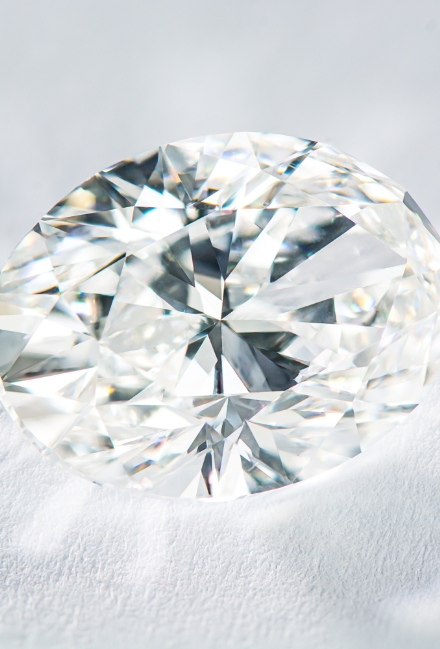
Lab diamonds are very different from diamond simulants. Although diamond simulants look a lot like diamonds, they aren't true carbon crystals and, therefore, not real diamonds. The simulants aren't as durable or beautiful as genuine diamonds since they do not possess the same chemical and physical properties as real diamonds. Simulants are sold at significantly lower prices than diamonds that have been created in laboratories. They are easily distinguishable by the naked eye from natural diamonds and lab created diamonds, even by an untrained person.
As a result of its thermal conductivity properties, a handheld diamond tester can tell you if a real diamond, either natural or lab grown diamond, is different from a cubic zirconia stone. However, As a result of the similarity of the electrical conductivity of some laboratory and natural coloured diamonds, it is possible that some of these diamonds may be misidentified as moissanites when using specific diamond testers. Despite the occasional false positive, the reason why gemologists are able to tell the difference between moissanite and diamond so easily is that moissanites and diamonds have different refractive properties. Moissanites have double and single refractive properties, respectively, whereas diamonds have only one refractive property.
Diamonds, which are grown under the same temperature and pressure conditions, have the same physical and chemical properties, be they formed inside the earth or in a lab. Diamonds that have been created in a lab are just as genuine as diamonds that have been mined but without the conflict or ethical issues associated with some diamond mines. In contrast to diamonds obtained from mining, lab created diamonds tend to be of superior quality due to their highly controlled environment and full control of their manufacturing process.
Some of the benefits of lab made diamonds include the following:
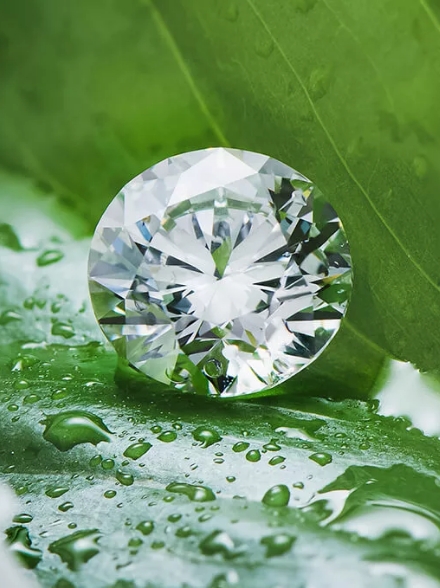
It's crucial to distinguish lab grown diamonds from diamond simulants to make an informed purchase. Regrettably, some unethical companies sell diamond imitations, and it's important to be wary of them. These companies may employ shrewd marketing tactics and use names like "synthetic diamonds," "artificial diamonds," "moissanite," "cubic zirconia," "crystals," and "diamond simulants" to make their products sound like lab grown diamonds. However, these items are not authentic diamonds, and it's essential to exercise caution when buying an engagement ring. We recommend reading reviews and verifying that you are buying a genuine lab grown diamond since an engagement ring is a substantial commitment that deserves careful consideration. Lab made diamonds are also known by the following alternatives which have the same meaning; Manufactured Diamonds, cultured diamonds, above earth diamonds, mine-free diamonds, ethical diamonds, CVD diamonds, HPHT diamonds. Our site main page covers in more detail lab diamonds UK and lab grown diamonds UK
The gemmologists at Novita Diamonds have helped thousands of satisfied customers purchase their dream lab made diamonds. We can assist you with this process through our state-of-the-art user-friendly website or by visiting one of our specialised locations, check lab grown diamonds London, lab grown diamonds Manchester or lab created diamonds UK.To find the perfect premium lab diamond, we recommend starting with our “Start With A Diamond” page. Here, you will find two tabs called "Available in Showroom" and “Recommended“ which features a selection of hand-picked lab grown diamonds. Both of those list of are carefully curated and constantly updated by our experienced team of gemologists, who have already done all the hard work of sifting through thousands of diamonds to select the best options for you. For more information, watch our "Available in Showroom" video
Novita Diamonds is here to assist you by curating and classifying lab diamonds. Our team of gemmologists takes care of all the work for you, making it easier to purchase the perfect lab created diamond. You can visit any of our showrooms located in countries all over the world, or you can use our state-of-the-art, user-friendly platform to find the ideal lab grown diamond ring. Simply select the shape, size, or any other desired parameters, and you will see a list of all the "recommended" lab created diamonds that have been hand-picked by our team of expert gemmologists. We currently offer over 3,800 lab diamonds in UK at any given time, and our gemmologists work hard every day to keep adding new stones to this list.
After selecting your diamond, you will be guided to a special section where you can choose premium lab diamond rings with over 120 unique designs made by our team of top jewellery designers. However, you also have the option to buy just the diamond without the ring by selecting the stone on its own. Finally, we would like to remind you that all customers purchasing a lab diamond in UK or lab diamond rings can take advantage of our 20% deposit."
Due to the fact that laboratory grown diamonds are as real as mined diamonds, lab grown diamonds are graded exactly like traditional diamonds, emphasizing cut, clarity, carat, and colour. Once they have been certified by a gemologist using the same scale and methods as mined diamonds, they will then need to be sent to an independent gem laboratory for certification. When you choose a lab grown diamond, you can be certain that it has undergone the strictest scrutiny so that it can be the centrepiece in a high-quality and stunning piece that is also ethical and environmentally friendly.
To grade lab made diamonds, the processed stones are first sent to a gem lab specializing in grading diamonds, and the most reputable labs include IGI, GIA, and GCAL, which all use the same 4c (cut, clarity, colour, and carat).
An independent grading process is conducted by several gemologists at the lab for each diamond. Basically, they judge the diamond on its size, flawlessness and clarity, as well as its cut. To determine the final grade, the individual grades are compiled and analyzed.
We have a full article about the 4Cs and how they impact the quality of the diamond here. To summarize the 4Cs, carat refers to the diamond's size and weight. Diamonds are graded by their lack of colour, with a fully clear diamond receiving the best grade. The cut is how well the rough diamond was processed and determines the brilliance of the diamond. Clarity refers to the visible lack of impurities or defects locked into the crystal.
Based on the results of the inspection, each diamond receives a quality rating. This process is intended to provide each diamond with an unbiased grade. It is not uncommon, however, for the same diamond to receive a different grade based on the criteria for each 4C grade at a different lab. Retailers and seasoned buyers sometimes prefer to rely on individual certifiers like IGI or GIA because of this. In practice, however, a lab diamond that receives a high grade from any reputable certification company is nevertheless an excellent diamond.
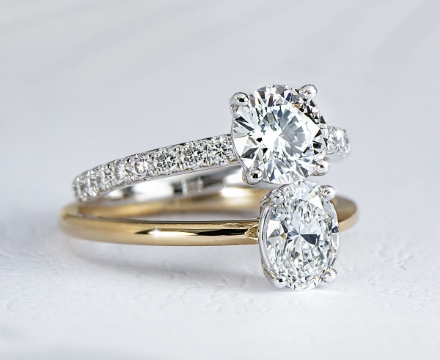
The claim that lab grown diamonds change colour over time is a baseless rumour. It was a fabrication propagated by the diamond mining industry. The Gemmological Institute of America (GIA) put this myth to rest when they began certifying lab grown diamonds, joining the International Gemmological Institute (IGI) in doing so. This means that the world's two most extensive gemmological authorities would not endorse any diamond that may alter in appearance over time. For a comprehensive overview of this topic, our team of expert gemmologists has authored an insightful article entitled "lab grown diamonds are forever".
Moissanites cannot be compared to diamonds as they are vastly different. Firstly, moissanites cannot be produced in true white colours, unlike diamonds. Secondly, they possess a rainbow-like sparkle that makes them appear more like costume jewellery than diamonds. Lastly, all moissanites display double refraction, which gives them an abnormal look regardless of how they are cut or polished. For a thorough comparison between diamonds and moissanites, we recommend reading our blog post titled "Diamonds VS Moissanites: the Truths and the Lies", in which we explore the significant distinctions between the two.
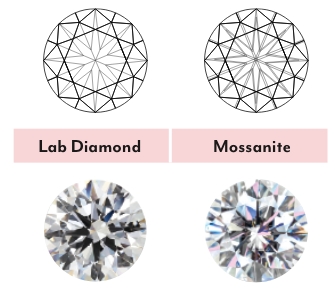
A moissanite tester is not suitable for testing lab grown diamonds because it is designed to detect the presence of boron. This element is used in the manufacturing process of both moissanites and lab grown diamonds. Therefore, using a moissanite tester to test a lab grown diamond will result in a false reading. Instead, a normal diamond tester can be used, and any reputable jeweller or diamond dealer should have a CVD tester available which give a much more accurate and definitive result.
Although both GIA and IGI are reputable laboratories, our gemmologists highly recommend IGI for individuals interested in buying lab grown diamonds. IGI was an early proponent of lab grown diamond certification and has since emerged as the industry's leading authority. This means that there is a broader range of lab grown diamonds available through IGI, and their prices are generally more competitive than GIA's. Additionally, it's crucial to note that GIA does not provide physical copies of certificates, while IGI provides both hard copy and online certificates, making it more convenient for consumers.
If you are in the market for a diamond, lab grown diamonds are currently the only ethical option. Prior to their introduction, consumers were compelled to buy mined diamonds that are infamous for their association with conflict or "blood diamonds" and their contribution to environmental degradation. With lab grown diamonds, mining is eliminated from the supply chain, and there is no risk of unsuspecting customers acquiring a conflict diamond. To discover more about this subject, we encourage you to explore our educational page on "ethical diamonds" or check out our blog post, "is the diamond Kimberley process reliable or a flop?". Our blog provides a wealth of information and perspectives on the diamond industry that you won't find elsewhere. At Novita Diamonds, we are committed to presenting you with the most up-to-date information and insights. Check our lab grown diamond rings guide to learn everything about lab diamond rings.
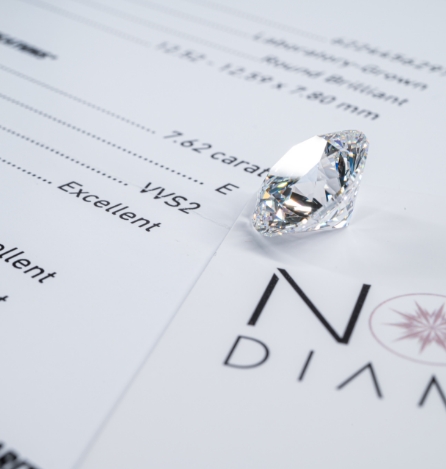
Lab grown diamonds are identical to mined diamonds minus the big price tag. On average you don’t only save 75% but also have the chance to do good as only lab diamonds can be eco friendly diamonds and real conflict free diamonds. And you should only deal with a company which specialises only on lab created diamonds, not one that happily sells both.
 TIPS
TIPSAbsolutely! Laboratory grown diamonds are 75% cheaper than a mined natural diamond. The difference in price is due to the high costs involved in mining compared to growing a diamond in a lab. However, once a diamond is in its rough form, the process of cutting, polishing, certifying, and transporting the diamonds is the same. Therefore, the difference lies purely in the production cost of the rough diamonds.
Short answer: yes. If you’re looking for a lab created diamond, it’s best to deal with an operator that only sells lab made diamonds. Specialised companies are known for being able to provide a higher level of service and product. It will always be better to deal directly with a specialist if one is interested in learning more about it or purchasing one.
View some of our most recent client creations and start gathering inspiration for your own special piece.
 PROS
PROSDiamond Mining always destroys the land, disrupts ecosystems, and wastes a lot of water and energy. With the introduction of new and reliable methods for growing diamonds in laboratories, mining is no longer the only method available for obtaining rough diamonds, thereby forever changing the mining industry. Because they are grown in a controlled laboratory environment, they do not require the mining and extraction of natural resources and have no environmental impact. A complete stop to diamond mining is necessary for the planet to heal, and man made diamonds, being the only realistic alternative, can help achieve that. To further learn about this you can go to our section ethical diamonds and eco friendly diamonds.
In contrast to the diamond mining industry, diamonds grown in laboratories do not lead to any conflict or human rights violations. The introduction of such a diamonds to the global diamond market has become the only way to combat blood diamonds. This will not be an easy process; experts say it could take decades, but it marks an important step toward a sustainable diamond industry. In our blog on blood diamonds, Novita’s top gemmologist discusses this in more detail
Since mined diamonds come in random shapes and sizes when extracted from the ground, cutters are often forced to sacrifice the quality of the diamond to gain more carats. Keep in mind that carats are the #1 factor that determines diamond prices. On the other hand, as opposed to mined diamonds, the manufacturers of lab made diamonds are able to make enough rough diamonds for cutters to work with, allowing them to have more material to cut better diamonds. You can learn more about a diamond cut here.
No, there is not. Throughout history, natural diamonds have been manipulated in price due to monopoly held by De Beers, as has been proven, many times, in the court of law. In contrast, lab made diamonds do not suffer from price manipulations or belong to large monopolies. This results in a fair price and value in the global market, here you can learn more about the monopoly of mined diamonds.
 CONS
CONSThe adoption of man made diamonds to the market has been relatively slow; the resistance from the mining industry has been in full force as one would expect since the introduction of lab stones in to the wider market. This is normal for any industry that is being disrupted. As of right now, all large high-end brands still do not sell lab created diamonds, and this does not appear to be changing anytime soon.
For lab created diamonds, GIA provides only an electronic certificate. This is done to attempt to downgrade laboratory grown diamonds in consumers’ eyes. Because of politics, GIA was late in entering the market; the mistake cost them dearly and left them forever in second place. Instead, IGI became the undisputed global leader for certifying lab made diamonds. For more details, please read the full story here GIA VS IGI.
 FAQ'S
FAQ'S
Yes, they are real diamonds. They are created using the same chemical and physical processes that happen naturally inside the Earth but are grown in a controlled laboratory environment where a starter seed of diamond crystal gradually becomes bigger as more and more carbon atoms are deposited on it. Lab made diamonds are chemically, physically, and optically identical to natural diamonds and are scientifically proven to be real diamonds. IGI and GIA, two of the world's foremost authorities on diamonds, coloured stones, and pearls, grade man made diamonds the same way they grade mined diamonds using the same scale.
The price is significantly lower than the price of mined diamonds. The exact price difference will depend on various factors such as the size, quality, and specific type of diamond, but on average, lab grown diamonds in UK are around 75% cheaper than natural diamonds. This is because the cost of producing rough is much lower than the cost of mining and extracting rough natural diamonds from the Earth. However, the rest of the process that a rough diamond, whether from a mine or a lab, goes through to be retail ready, like cutting, polishing, certification, shipping, and insurance are all exactly the same.
To give you an idea of how much you can save, if a mined diamond costs £10,000, an equivalent lab diamond in UK will cost £2,500.
Yes, they do. When using a diamond tester, all lab created diamonds will test as diamonds. Chemically, physically, and optically there is no difference to a natural diamonds, so they will exhibit the same properties and characteristics when tested. This includes hardness, refractive index, thermal conductivity, and other properties that are unique to diamonds, both mined and man made.
Yes, most lab diamonds have inclusions, just like natural diamonds. Inclusions are natural imperfections that are found within diamonds, and they can occur in both natural and lab made. Inclusions can take many different forms, such as tiny bubbles or carbon deposits that were trapped inside the diamond as it was forming. Just like natural diamonds, most diamonds created in labs have flaws, and only very few become flawless. Check our 4Cs guide to learn more about colour, clarity, cut and carat of diamonds.
Yes, all lab diamond in uk and lab diamond ring can be insured. All lab created diamonds are considered to be real diamonds, so they can be insured just like mined diamonds. You can purchase insurance from any company that accepts jewellery insurance. Insurance policies vary but usually they cover the cost of replacing or repairing your item if it is lost, stolen, or damaged. It is important to read the terms of your insurance policy carefully to understand what is covered and what is not.